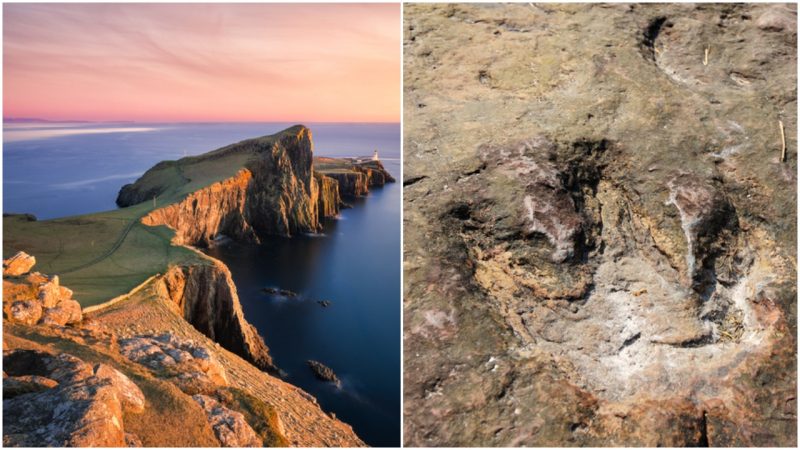Huge Dinosaur Footprints Discovered on Scottish Coast

MORE THAN 160 million years ago, long-necked dinosaurs called sauropods lumbered through the ancient lagoons that dotted what is now Great Britain. Now, dozens of their footprints have been found on the forbidding, wave-pounded coast of Scotland’s Isle of Skye.
Researchers Davide Foffa and Hong-Yu Yi, University of Edinburgh paleontologist Dr. Stephen Brusatte and his student Paige dePolo went back to the site to take a closer look at the prints and learn more.
They are not so easy to access, located in the wave-pounded tidal zone of a headland called Brother’s Point. A collaborative study of the footprints by the University of Edinburgh, Staffin Museum, and the Chinese Academy of Sciences, led by dePolo, was presented in the Scottish Journal of Geology, along with a full catalog of images of the 50 footprints.
The team has dated the tracks at about 170 million years of age, and conclude that they were made by the gargantuan animals as they waded through a shallow lagoon. In the distant past, when these tracks were made, Earth was a very different place. It was shortly after the time when Pangaea started to break apart, and our planet was transforming into the continents we know today.

In those days, experts believe that the area of Skye was positioned somewhere in the subtropic belt, with a much warmer climate. According to Brusatte, “This was a subtropical kind of paradise world, probably kind of like Florida or Spain today.”
The latest find of dinosaur prints in Scotland is a source of great excitement in the worlds of paleontology and geology because they are from the Middle Jurassic epoch.
As Brusatte explained to National Geographic, this was an important time in dinosaur evolution. It is probably the era when the first birds appeared and the largest species of a sauropod were thriving, but dinosaur fossils from this period are scarce compared to other periods.
The recent find follows hot on the heels of the discovery in 2015 of hundreds of Middle Jurassic sauropod tracks at another location on the Isle of Skye, Duntulm beach. The Brother’s Point prints were found in older rocks than those of the 2015 discovery.
The study has increased knowledge of dinosaurs from this era significantly and offered some valuable insights: for instance, sauropods were roaming this corner of the globe for a greater period of time than previously thought.
Sauropods were the largest land-dwelling animals at that time, and despite their size, they were plant-eating creatures. The field team not only mapped tracks from sauropods; scattered among them are distinctive three-toed prints belonging to theropods, a distant and more primitive relative of the Tyrannosaurus Rex. These meat-eating dinosaurs were able to grow to about 6.5 feet in height.
The largest sample of theropod footprint left on the Isle of Skye was about 19.6 inches across, which is still nowhere close to the largest belonging to a sauropod–one example of these was reportedly some 27.5 inches across.
The endeavors of the researchers were not without challenges. As the area is continuously hammered with cold winds and rain, the team could not easily proceed with mapping the area. Another challenge was the high tides that regularly reclaimed the footprints, hence the team was constantly clock-watching while they measured and inspected the tracks on the rocky ledges. They also had to improvise with cameras and equipment, but in the end, it paid off, as 3-D images of the terrain were produced.
Part of the dinosaur traces found were actually hand prints, Brusatte explained, a clue that it was a huge creature in question, like the sauropod. This enormous animal, which could grow up to 50 feet long, needed all four limbs to support itself while lumbering around. The theropod tracks indicate that these dinosaurs walked only on their hind legs.
Sauropods were previously thought to have been purely amphibious creatures, the Smithsonian notes. Paleontologists of the early 20th century believed that sauropods could not walk on the land because of their weight.
Evidence that was acquired later on proved the contrary. And the recent finds coming from Scotland suggest that, while some representatives of the species were able to move comfortably on land, others opted to wade through waters near the coast.
Related story from us: This dinosaur had a swan-like neck and crocodile teeth and walked like a duck and swam like a penguin
In fact, Brusatte remarked to National Geographic, sauropods “were so dynamic and so energetic,” meaning it is likely that they were abundant in various environments as their species spread around the world.
Brusatte also acknowledged that more Middle Jurassic era dinosaur fossils could lurk hidden on the Isle of Skye, hence this might be only the beginning of what this Scottish island has to offer to the knowledge of dinosaurs in the world.
